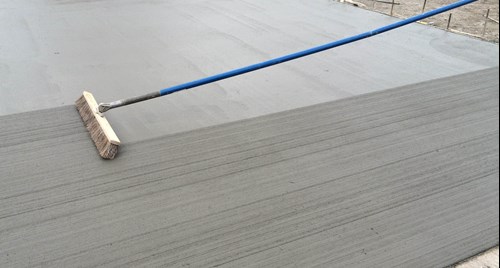While the use of reinforcing fibers in concrete may not have the same curb appeal as glass skyscrapers or multi-level highway interchanges, their use and acceptance in the concrete industry is becoming more common with universities, engineers, architects and concrete contractors all becoming familiar with their benefits and advantages in everyday business use.
Fiber reinforcement is not a new concept, with actual projects dating back nearly 2,000 years. However, over the past decade, there has been a tremendous rise in the acceptance and construction of commercial concrete projects using fiber. In particular, the use of macro-synthetic fibers has become very popular due to more engineering approvals, ease of construction, improved durability and lowered cost. These large coarse fibers are able to be introduced to the concrete fabrication process and can provide the equivalent amount of steel reinforcement for many pavement, architectural, precast concrete and other lightly reinforced applications. Macro-synthetic fibers can also provide a safer and more sustainable construction practice by reducing the overall carbon footprint of construction, reducing the construction time on-site and increasing the quality of the concrete by providing additional benefits such as improved resistance to deterioration from weathering.
Sound walls, stamped and patterned concrete, polished floors, sculptures, residential foundations, warehouses and pavements are all now incorporating the use of fiber reinforcement with various fiber types, dosage rates and engineered calculations to provide the owner with the desired result — a concrete structure that “should be” maintenance free, provide long-lasting value and enable a sense of pride upon construction completion.
As part of the ongoing R&D on the use of fiber reinforcement and to assist in promotional efforts of its products and services, The Euclid Chemical Company recently constructed a parking lot on its Cleveland campus to replace a severely deteriorated asphalt lot with a fiber-reinforced concrete pavement. In combination with the use of fibers, various chemical admixtures were also incorporated into the concrete to reduce the opening of the sawed joints, which are a required and common practice in concrete pavement construction to prevent unwanted cracking. These joints are typically constructed immediately after the concrete has hardened but over time can become damaged through use by vehicular traffic and environmental attack. By reducing the joint widths and frequency, and adding fiber reinforcement, the concrete pavement should last much longer than a typical parking lot.
For this project, four different sections of concrete were placed under similar pouring conditions with combinations of fibers, shrinkage reducing and shrinkage compensating admixtures and a quality concrete mixture design. These combinations of products were all intended to affect the normal shrinkage characteristics of concrete and improve them. A significant number of engineering tests were also performed with this project including flexural tough- ness, which measures the performance of the fiber reinforcement in resisting cracking. Compressive strengths and concrete beams to measure shrinkage characteristics will be measured over the course of 12 months to establish and predict long-term performance.
This concrete pavement was turned over to use in November 2015 and has not exhibited any cracking or signs of distress even after several large loads have been applied to it. Further, the joint-width measurements that are being taken at regular intervals have shown no signs of opening. This data will all be compiled and presented to the engineering community to provide a “real world” example of quality concrete construction.

About Michael Mahoney, P.Eng
Michael Mahoney is the Director of Marketing and Technology for Fiber Reinforced Concrete at Euclid Chemical. In 1997, he obtained his Master’s degree in Civil Engineering from the Technical University of Nova Scotia, Halifax, Nova Scotia, Canada where he helped to develop and patent TUF-STRAND SF, a macro-synthetic fiber for concrete reinforcement. Michael is a Fellow of the American Concrete Institute, and a member of the National Pre-Cast Concrete Association and American Society for Testing and Materials. He is also a past president for the Fiber Reinforced Concrete Association and has been with Euclid Chemical for 15 years.